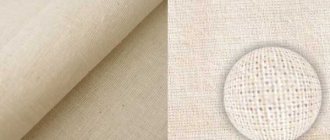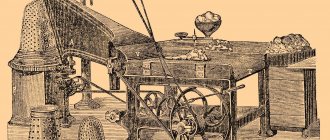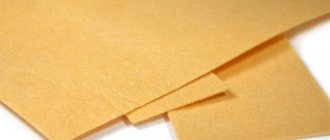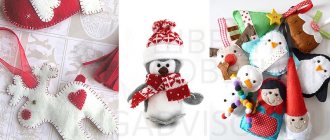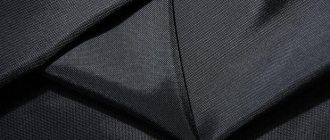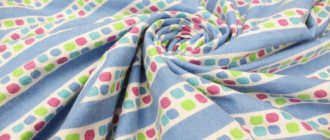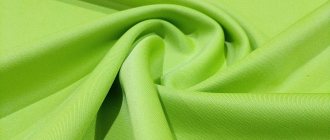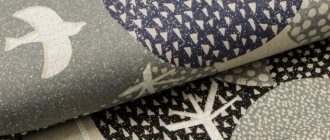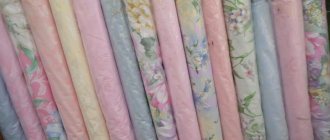Felt is a felt-type fabric that has excellent performance and performance characteristics; we will describe them below in our article with a photo and answer the question: “How much does a meter of felt cost?”
Felt material, what is it, is a type of felt, which is produced from the fluff of goats and rabbits (it is quite thin). At the same time, if the felt material has a thick, soft and short pile, then it is usually called velor.
Felt fabric has a rather unusual structure and, by and large, is not fabric. It can be classified, rather, into the category of non-woven materials, because production is carried out using the technology of felting wool. In other words, there are no intertwined fibers here. You can find all woolen materials here.
Main characteristics
Dense and rigid felt fabric, a photo of which can be viewed on our website, according to GOST, is produced using rabbit and goat hair (or artificial substitutes). This material is quite soft to the touch, pleasant, has good strength characteristics and a relatively high density. The surface can be piled or smooth.
Among the interesting properties of felt are:
- Plastic;
- Pleasant tactile sensations;
- High strength (difficult to tear with hands);
- The edges do not crumble;
- The material has no reverse side.
Kinds
Sheet and roll, artificial and natural, wool and thin, in a word, felt can be different. The main material in texture and properties is considered to be natural wool material, which has good antiseptic and thermal insulation properties. Parts for clothing, hats, and shoes are made from it.
Based on the length of the villi, the following types are distinguished:
- Suede - no more than 0.5 mm
- Short pile (with short thick and soft pile) - up to 1.5 mm
- Velor - up to 2.5 mm
- Long pile - up to 12 mm
The composition of felt fabric depends on its type:
- Wool blend: obtained from a mixture of wool and viscose. Moderately soft and easily painted in bright areas.
- Acrylic (artificial): obtained from synthetic fibers. The main advantage is that it does not lose its shape
- Bamboo: obtained from a mixture of bamboo fiber and viscose. It is very durable and pleasant to the touch.
Read the article: “Cashmere - what kind of fabric is it”, you will learn all the features.
Felt production technology
As mentioned above, the structure of felt does not have interlacing threads; accordingly, the material belongs to non-woven types obtained by the folding method. By the way, felt is also popularly called felt or yarn after dry felting.
Modern felt production.
Naturally, to produce felt on an industrial scale, automated production has been established around the world. The raw material for making felt is soft wool or fluff collected from animals, most often a goat or a rabbit. Modern materials, of course, contain synthetics and artificial components. What would it be like without them!? During manufacturing, the raw material fibers are moistened with hot steam, then they are heated, and then friction is applied. As a result, sheet material (sheet thickness varies from 0.5 mm to 10 mm) or rolled material up to 220 cm in size comes off the conveyor. It is also possible to see semi-finished products in the form of caps for making hats and thin felt boots. Most often, felt has a single bright color, but it is also possible to add various prints. Interesting! It is worth noting that the color range of felt can reach up to 144 different shades. Also, felt does not have a front or back side, it is durable and comfortable, the edges of the felt do not crumble and they don’t even need to be processed.
Scope of application
Despite many positive characteristics, today felt fabric is used quite rarely. At the same time, the production of caps, coats, hats, sweaters, pants and other items of clothing has been established, but it is difficult to find such products in stores in a wide variety (rather, only at specialized points of sale).
Decorative felt, in turn, has its own popular area of use - the production of various fabric crafts, toys and other things, the main operational value of which is the role of decoration. The fabric is actively used in the handmade industry.
Advantages and disadvantages
The advantages of thin felt have already been mentioned above. In this case, it is necessary to highlight the main disadvantages of the fabric, which must be taken into account before direct use:
- The material shrinks over time, so clothes and decor made from it gradually acquire an unattractive appearance;
- Plain and colored felt is a breeding ground for moths;
- The fabric is highly hygroscopic, so it easily absorbs moisture.
Types and properties of felt
Depending on the source raw material, the material can be:
- Woolen. Felt of natural origin is made from the wool of a goat, rabbit, sheep, etc. Wool felt is environmentally friendly, has antiseptic properties, and has high thermal insulation. Durable, dense, not afraid of dirt and contact with fire. The disadvantage is the high price, change in shape when water gets in, as well as the unpleasant odor of the wet fabric. Used for crafts, applications, decorations and technical purposes.
- Wool blend . Composition: 50% wool and 50% viscose (possibly adding acrylic). Soft, plastic, cheap, large selection of colors, does not irritate the skin. The main drawback is the tendency to shed and wrinkle.
- Acrylic (artificial). This type is made from recycled plastic. The surface of acrylic felt is distinguished by its shine and long-lasting rich color. Felt is easy to clean (the shape remains unchanged after washing). Unfortunately, man-made fibers make felt unhygienic and prone to fire. A “creaking” effect appears in the work. It is also very slippery in your hands.
- Bamboo . The composition includes bamboo fiber with viscose. It has an antibacterial effect and high strength, and also has a slight shine, silk and soft structure. Very pleasant to the touch. Large selection of colors. The main disadvantage is loss of strength when wet and deformation. It is dry clean only. It has a high cost. It is worth noting that it is very rare in Russia.
- Polyester. Durable enough for long-term use. In light colors it tends to shine through.
- Simulated. Another type of felt that allows you to make products of absolutely any shape. Modeling properties are achieved by special impregnation and wetting of the raw material before work. An important advantage of simulated felt is the absence of deformation during operation.
- Eco-felt. Obtained after processing of secondary raw materials. It can be both soft and hard. Keeps its shape like whatman paper. Thin sheets are uniform in structure and do not show through, do not stretch or tear. Widely used for children's crafts.
Felt has different densities and thicknesses. For example, the thickness of felt can vary from 0.5 to 10 mm. The thinnest felt sheets are designed for making small parts (they are easy to cut with scissors). Thicker sheets are usually used to make the base for toys and clothing, because... This material is dimensional stable. The density of felt is 250 – 700 g/m2. It depends on the scope of application. For example, for florists a density of 250 g/m2 will be enough, but to make a coat or hat of such weight it will not be enough.
Varieties of colors.
So, I propose to summarize the main properties and characteristics of felt. Among the most important features of felt material, I highlight: plasticity, high strength, the absence of a reverse side and, of course, “problem-free” edges that do not crumble and do not require additional processing. I can’t help but mention the disadvantages of felt. Knowing its negative sides, you can avoid some mistakes when using it:
- Felt is an excellent place for breeding moths (especially wool moths).
- Over time, the material shrinks and deforms, which in turn leads to an unattractive appearance of clothing and decor.
- Felt is a hygroscopic material, so it absorbs moisture very easily.
Interesting Facts
On the modern market you can find several types of felt fabric: wool (more than 90% wool) or wool blend (about 50%). In addition, many modern companies make the material not from wool, but from a polyester or acrylic base. That is why during the purchase it is necessary to take into account the composition of the fabric material, its type and other aspects.
Felt is very popular among craft products and canvases. The price per meter starts from 150 rubles per meter.
How to wash felt? Manually, in warm water with the addition of a product. In addition, our portal describes in detail how to properly care for felt fabric so that it does not shrink during direct use and does not lose its original appearance and bright colors over many years.
Watch the video for tips on working with felt:
Description of felt and its varieties
Felt is a non-woven material, as it is made by matting fibers and additional heat treatment. Consequently, there are no intertwining threads in its texture and the fabric is tear-resistant. They produce felt in rolls and sheet felt only in a single color. Handicraft stores sell this material in sets of A4 size.
Its density varies from 1mm to 5mm. The thinnest is most often used to make appliqués and toys; the thickest is used for decorative baskets, bags, flower pots, clothes and hats. There are several types of fabric based on their composition.
Skilled needlewomen even create unusual three-dimensional paintings from felt.
Types of felt by composition
- Wool felt consists of 90% or more high-quality, at the same time thin and durable fibers from goat and rabbit hair. Like any other woolen fabric, wool felt is prone to shrinkage, pellets appearing on the surface and being eaten by moths. On the plus side: it holds its shape well (especially thick felt), and it retains heat if you sew clothes from it.
- Blended felt contains 50% wool and 50% acrylic or viscose. Unlike pure wool material, mixed wool does not hold its shape well, but is softer and more pliable in processing. Its surface is smoother and the tendency to shrinkage is lower.
- Acrylic felt is the thinnest of all varieties of this material and less durable. Its thin texture allows you to create objects that require repeated folding and the formation of folds and curvaceous shapes, but at the same time acrylic has an unpleasant squeaky, shiny and slips when working with it.
- Viscose is a very durable and soft felt, has a smooth, slightly shiny surface and a wide range of colors.
- Polyester material has the highest strength and is a leader in durability. It is from it that the most wear-resistant bags, covers, cases and furniture upholstery are obtained.
Modeled felt is another type of fabric. Thanks to the special impregnation of this fabric, you can give it absolutely any shape by wetting it. Once completely dry, the shape remains in place until you decide to change it again.
Floral felt is the thinnest, most often made from polyester fibers
Felt material is divided into types according to the length of the pile.
Short-haired - thick soft fibers up to 1.5 mm long./
Long-pile - the length of the pile reaches 12 mm.
Suede - dense thick fibers up to 5 mm long.
Velor - with a pile length of about 2.5 mm.
Reviews
Inna: I just recently became interested in creating crafts. I love making flowers and toys; it turns out very original and interesting. Although I’m still getting the hang of it, I can say with confidence that this material is very comfortable and ideal for these purposes.
Marina Sergeevna: My daughter makes toys from this material at school in a circle. Very easy to process, and the result is wonderful! She does it so easily and beautifully!
Alina: I'm crazy about felt hats, I have about 5 of them in my wardrobe. The wide brim hat is my favorite. They are easy to care for, the main thing is to dry them properly after washing.
